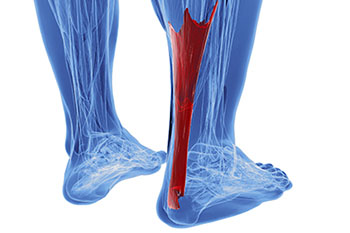
Achilles Tendinitis: (also spelled Achilles Tendonitis)
The Achilles is the human body’s strongest and thickest tendon and runs down the calf on the backside of the lower leg, connecting the calf muscle to the heel. We use our Achilles tendon whenever we are in motion walking, running, or jumping. The Achilles is tough enough to stand up to forces of 1,000 pounds or greater, but it is the most commonly torn tendon due to athletic injuries.
Achilles tendinitis occurs when the Achilles tendon becomes inflamed due to overuse, stress, injury, or degeneration. Achilles tendinitis and its accompanying pain and swelling can strike anyone, from professional athletes to weekend exercisers and athletes, as well as youth sports enthusiasts.
What Are Some Causes of Achilles Tendinitis?
- Sudden trauma to the tendon from causing it to stretch too abruptly, such as when sprinting or jumping
- Overuse
- Fast increases in walking or running distances or speeds without giving the body the chance to adapt as it normally would by introducing slight increases over time
- Quickly resuming sports or exercise activities after long periods of inactivity
- Failure to properly and adequately stretch before exercise or activity
- Repetitive climbing up stairs or running up hills
- Inappropriate shoes, sneakers, sandals, or other footwear
- Excessive foot pronation, or turning the foot down or to the inside when walking or running for longer-than-usual periods of time
What Are Symptoms of Achilles Tendinitis?
- Mild pain after exercise or activity that gets worse over time
- Pain, aching, or nagging discomfort along the back of the lower calf, especially after running or exercise utilizing the calf muscles
- Persistent swelling in the back lower calf area, not only during or after exercise
- General stiffness, tenderness, or tiredness in the lower calf area, especially after a night’s sleep when the feet first hit the ground for the day
How Is Achilles Tendinitis Treated?
- Reduce stress and impact to the Achilles area, as well as rest the tendon by choosing non-impact sports or exercises
- Wear a brace or support bandage to limit the tendon’s motion or a walking boot to further rest the Achilles and avoid additional stress to the area
- Insert appropriate heel orthotics into shoes and sneakers, or wear heel-supportive footwear to alleviate stress and strain on the tendon
- Stretch the tendon and surrounding area muscles through physical therapy and/or at-home stretching regimens
- Take over-the-counter non-steroidal anti-inflammatory medications on a temporary basis to treat pain and swelling (ask your doctor first)
- Massage and ice the area regularly
- If the above treatments do not solve the Achilles tendinitis, surgery may be necessary
